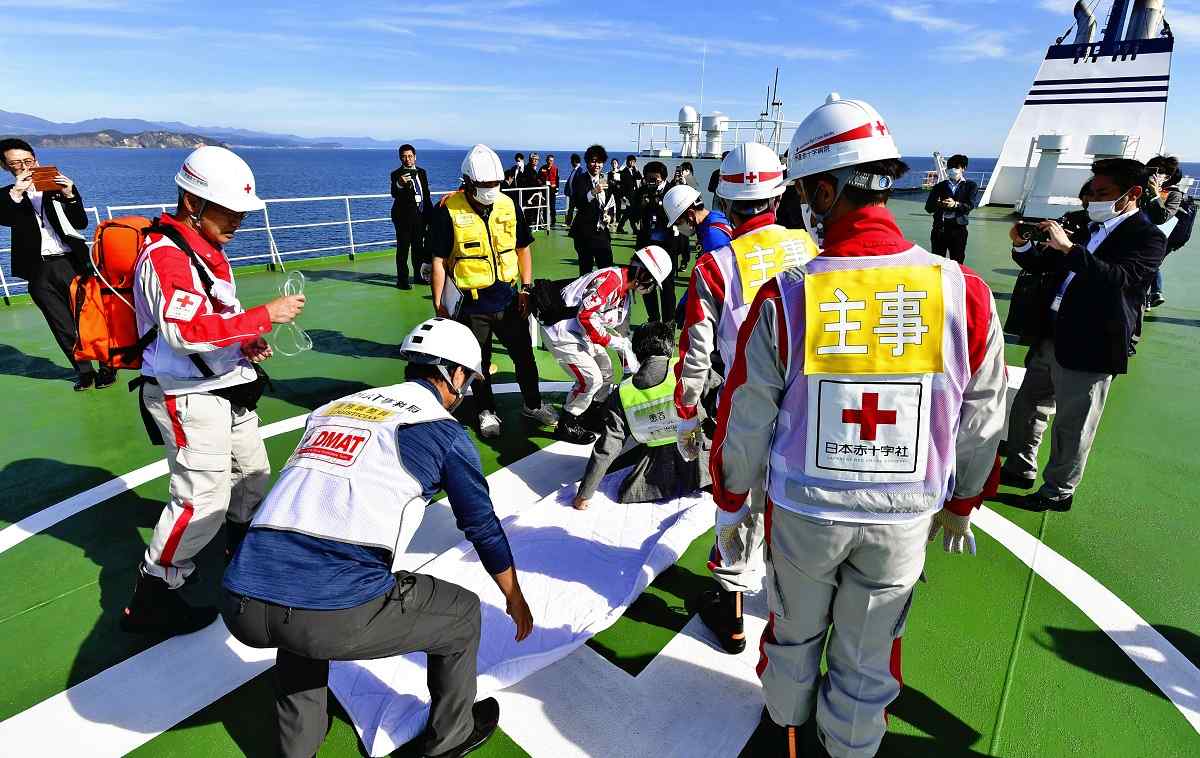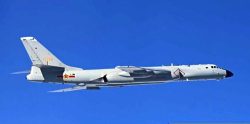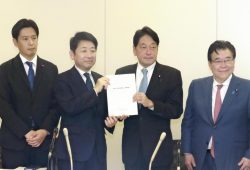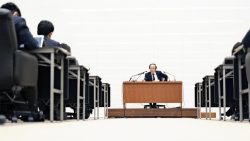Japanese Government Prepares to Set Up Hospital Ship; Will Start by Using Car Ferries from Next Fiscal Year

Medical workers practice hospital ship operations aboard a car ferry in Muroran Port in Hokkaido on Oct. 14.
1:00 JST, October 23, 2024
The government plans to start operating a hospital ship outfitted with medical equipment and inpatient beds next fiscal year.
When earthquakes and other large-scale disasters occur, the ship will assist hospitals in affected areas by treating injured people and transporting those who need inpatient care.
The government plans to utilize private-sector car ferries initially. Earlier this month, the government conducted a drill simulating actual duties, kicking off full-scale preparations for actually implementing the plan.
According to the Cabinet Secretariat, the hospital ship will dock at ports near disaster-hit areas, transport inpatients from local hospitals to those in more distant areas, treat lightly injured people inside the ship and supplement the medical functions of hospitals on the land.
As the ship will not have an operating room, it will not be able to treat seriously injured people.
One example of such a ship in action is the Mercy, a U.S. Navy hospital ship with 1,000 beds that was dispatched to Indonesia following an earthquake off the island of Sumatra in 2004.
At the time of the COVID-19 pandemic, the Mercy was used as a place for patients with non-pneumonia symptoms to recover.
In Japan, the establishment of a hospital ship was discussed in the wake of the 1995 Great Hanshin Awaji Earthquake.
Later, after the occurrence of many more large-scale disasters, including the 2011 Great East Japan Earthquake, a law on preparing to provide medical care by using ships in the event of disaster, which stipulates the use of a hospital ship, was passed in June 2021 as a lawmaker-sponsored bill.
Though the law stipulates that the government is to possess a hospital ship, an estimate in fiscal 2020 showed that building a new one with 500 beds would cost about ¥43 billion.
Therefore, as a first step, the government will rent private-sector car ferries for the purpose, on the presumption that it will possess a hospital ship sometime in the future. In the meantime, it will look into what kinds of medical equipment and facilities will be necessary.
The Cabinet Office, which is in charge of operating the planned hospital ship, has asked several shipping companies for their cooperation. The plan is to pay to rent a car ferry to respond to disasters.
Doctors and other staff of the Japanese Red Cross Society will board the rented car ferry and Red Cross equipment will also be brought on board.
Tents set up in spaces that are usually used to park cars, as well as passenger rooms in the ferry, will be used for hospital beds.
On Oct. 14, a drill was conducted in Muroran Port in Hokkaido. About 30 medical workers belonging to groups including Disaster Medical Assistance Teams (DMATs) participated in the drill and confirmed processes for such tasks as bringing an ambulance onto a ferry.
Based on the results of the drill, the government aims to compile dispatch and activity manuals by the end of this fiscal year.
As was seen in the Noto Peninsula Earthquake, if the ground at a port is upheaved, ships will be unable to come alongside its pier due to the risk of running aground. Thus, there are concerns that a car ferry or a hospital ship would be unable to do its job in such cases.
Some officials in the Health, Labor and Welfare Ministry also voiced concern about spending so much money to obtain a hospital ship.
Yoshikazu Maruyama, a doctor and director of disaster medical care for the Japanese Red Cross, said: “As Japan is an island nation, the sea offers an effective way to reach places. In the future, establishing [a hospital ship] will also help significantly in strengthening preparations for disasters such as a predicted Nankai Trough earthquake.”
Maruyama, an expert on disaster medical care, added, “However, because it is unclear how often the planned ship will be dispatched, there’s also a need for a thorough discussion on how to also make effective use of it in peacetime.”
"Politics" POPULAR ARTICLE
-

Japan to Support Central Asian Logistics Route That Bypasses Russia, Plan to Be Part of Upcoming Summit in Tokyo
-

Japan to Tighten Screening of Foreigners’ Residential Status by Providing Information of Nonpayment of Taxes
-

Takaichi Cabinet Approval Holds at 72% as Voters Back Aggressive Fiscal Stimulus, Child Benefits
-

Chinese, Russian Bombers Flew Unusual Path by Heading Toward Tokyo; Move Likely Meant to Intimidate Japan
-

Takaichi Meets Many World Leaders at G20 Debut in Johannesburg; Speaks with Heads of Countries Including Italy, U.K., Germany, India
JN ACCESS RANKING
-

Keidanren Chairman Yoshinobu Tsutsui Visits Kashiwazaki-Kariwa Nuclear Power Plant; Inspects New Emergency Safety System
-

Imports of Rare Earths from China Facing Delays, May Be Caused by Deterioration of Japan-China Relations
-

University of Tokyo Professor Discusses Japanese Economic Security in Interview Ahead of Forum
-

Japan Pulls out of Vietnam Nuclear Project, Complicating Hanoi’s Power Plans
-

Govt Aims to Expand NISA Program Lineup, Abolish Age Restriction
























